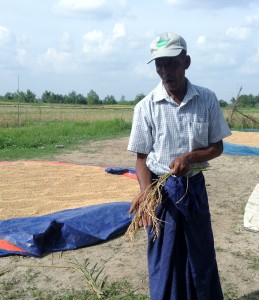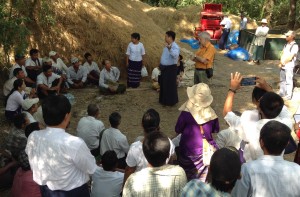Millions of Asian rice farmers struggle with low-quality grains, which are brought about by poor postharvest management, inappropriate technology, and a lack of understanding of the factors that affect rice quality. These problems result in a loss of potential income for farmers and lesser available rice in the market. The Learning Alliance (LA) is a way for actors in a rice value chain to work together and encourage cooperation to increase adoption of technologies, facilitate stronger partnerships, and use resources sustainably. Through LA, the International Rice Research Institute (IRRI) facilitates a network of stakeholders in the context of improving rice postharvest management. The alliance in Myanmar, composed of farmers and IRRI’s local partners from the rice value chain, aimed to produce better-quality rice and sell it to larger markets. Before Myanmar, the method was also used in various Southeast Asian countries where value chain actors similarly sought to improve their country’s postharvest systems.
To reach U Aung Kyi’s rice farm takes 45 minutes by boat from Bogale Township to Kyee Chaung Village, situated along the Ayeyarwady River. This river, the country’s main waterway, serves as a trade thoroughfare connecting villages along the delta with large markets such as Yangon. In the past, U Aung Kyi sold his sun-dried paddy to a village trader who offered low prices. The rainy season would make him worry that his grains would not dry in time and eventually deteriorate. Even worse, severe weather conditions threatened the loss of his entire crop.
This experience resonates with thousands of farmers in Southeast Asia, who face threats to food security and limited opportunities to obtain a higher profit because of inefficient technologies and the poor quality of rice grains.
Now, U Aung Kyi stands in a small room in Bogale Township, with about 20 more people, sharing how he was able to sell good-quality paddy at a higher price in Yangon. “During the monsoon season in 2014, my paddy was very wet so I dried it using the flatbed dryer that IRRI, PPHDG (Pioneer Postharvest Development Group), and GRET (Professionals for Development) established in Kyee Chaung Village,” he said. “I used the dryer again the next season. I was able to obtain better quality (paddy) and sold it at the Yangon market.”

The flatbed dryer is a tried-and-tested technology from Vietnam that IRRI helped to introduce in Myanmar to reduce postproduction losses.
The gathering in Bogale Township started from a participatory impact pathway analysis (PIPA) workshop organized by IRRI in December 2013,through the Livelihood and Food Security Trust Fund (LIFT) project of the United Nations Office for Project Services, to bring the rice value chain actors in the Ayeyarwady Delta together. These actors had a shared interest in improving the postharvest systems of farmers by using the flatbed dryer. Toward the end of the workshop, the participants, who included representatives from two international nongovernment organizations and one private-sector company, agreed to establish a village-level LA around the flatbed dryer to help farmers in Kyee Chaung and nearby villages improve their grain quality and, in due course, their income.
An innovative way of learning and working together
The partners quickly realized that raising quality and profits would require changes not only for but also for many stakeholders along the rice value chain. The LA is a platform for multiple stakeholders—in this case, actors in the rice value chain—that encourages collaboration to address a complex problem for which they have a common interest. In Myanmar, for example, traders want to buy high-quality paddy to maximize profits, while farmers want to obtain higher prices for their crop and reduce postharvest losses to increase income. The LA provided a common ground for farmers and traders, together with researchers, government extension staff, NGOs, millers, and other service providers, to discuss strategies and find incentive mechanisms. The LA facilitated discussions on various issues concerning ownership, capacity building, and linking farmers to reputable markets that provide premium prices.
The case in Myanmar is just one example of how the LA works in improving postharvest systems in Southeast Asia. The concept of the LA was introduced at IRRI in 2009. It uses participatory approaches, which help representative stakeholders in rice postharvest to plan, implement, and share resources with the goal of producing high-quality grains with minimal losses.
“We need a flexible platform in which we can bring these different value chain actors together,” explained Martin Gummert, IRRI postharvest senior scientist. “The LA enables farmers, traders, millers, the private sector, scientists, and other implementing partners to work together toward a common goal, and IRRI serves as the facilitator of the process. We have the technology, in this case a dryer that serves as an entry point to overcome a problem, such as poor grain quality. We then facilitate learning about its use and how to sustain it, together with partners who share a similar goal and would have the resources for complementary initiatives.”
After the dryer was established, GRET and Welthungerhilfe (WHH) immediately organized community groups to coordinate use of dryers in the village and established the “dryer committee” to ensure proper and sustainable operation of the dryer. They also provided warehouses where farmers could store their grains after drying and sell them when the market price was more favorable. PPHDG, on the other hand, provided technical backstopping for dryer operators to ensure that the dryer was used and managed properly.
Plan, act, reflect

The LA is characterized by iterative learning cycles of small groups in the network. A key part of a learning cycle involves a facilitated reflection activity on what happened, what they experienced, and what resulted from it for future planning and implementation. Then, the results of reflection activities feed into subsequent learning cycles, which allow farmers to identify other emerging concerns. U Aung Kyi is a member of the village-level LA that tested whether using the flatbed dryer could result in good-quality rice and whether such rice could be sold for a higher price.
Established in Cambodia, Vietnam, and the Philippines, these IRRI-facilitated alliances led to notable outcomes, such as the commercialization of the IRRI Super Bags in the Philippines , the use of combine harvesters in Cambodia (see Machines of progress) and laser leveling in Vietnam (see Laser-guided dreams). Aside from these, better capacity of stakeholders and improved practices and social arrangements have emerged to support innovation in the communities.
Bringing the learning further
Currently, the Closing Rice Yield Gaps in Asia with Reduced Environmental Footprint (CORIGAP), which is supported by the Swiss Agency for Development and Cooperation, continues to venture into how multistakeholder processes can be best used in other parts of the value chains in six rice-growing countries across Southeast Asia, including Myanmar. Similarly, the MyRice project of the Australian Centre for International Agricultural Research also conducts LA activities in Myanmar, which targets improving smallholder farmers’ profitability and productivity of rice-rice and rice-pulse cropping systems.
Learning topics vary in different countries because alliance members identify different problems that need immediate attention, such as reducing environmental footprints or the sustainability of rice production. The most important thing is that beneficiaries are able to identify their need, and they find a common ground that the CORIGAP and MYRice project can help address.
“The formation of the alliance is not just about the farmers or end-users learning about the technology; it is also a learning process for us, as scientists and implementing partners, on how to work harmoniously toward a more targeted change for the community,” explained Engr. Gummert.
U Aung Kyi and the alliance members recognize the importance of having the dryer in their community, though they know that sustaining its use and building market models around it is still a work in progress. “We find it difficult to encourage other farmers to use the dryer,” shared U Zaw Minh Htike, another LA member.
Recognizing this challenge, the members started an information campaign by designing print materials explaining the benefits of using the dryer. The information was presented in the form of a traditional poem. “This is to convince millers and traders to buy grains that were dried from the flatbed dryer,” said U Zaw Minh Htike.
On the back of a flyer they produced, he points to an image they conceptualized of three interlocked hands. He tells the alliance members, “All of us should be partners: farmers, traders, and millers. We should work together to produce high-quality grains, and maybe, someday, bring Myanmar rice to the export market.”

With that in mind, and having learned the importance of producing high-quality grains and selling to markets that buy at higher prices, the group knows that this is just the beginning and their vision is bound to come to fruition soon.
The joint learning process brought about by PIPA and the LA provided more than a working technology that they could use. It improved the capacities of rice value chain actors and provided an enabling environment for them to explore ways of working together and with other interested groups. Through this experience, farmers realize that they can be value chain players who have a more active hand in the profits they make from their harvests. The inclusive learning approaches also brought in new and trusted allies for these rice value chain actors who share a similar goal of launching Myanmar back into the rice export market.
Ms. Quilloy is a communication specialist with the IRRI Postharvest Unit and Learning Alliance facilitator, Ms. Flor is an IRRI scholar, and Ms.Azucena is a science communication specialist.






